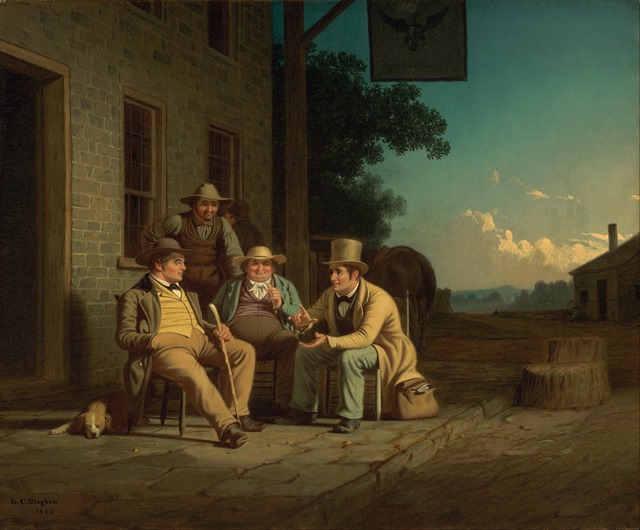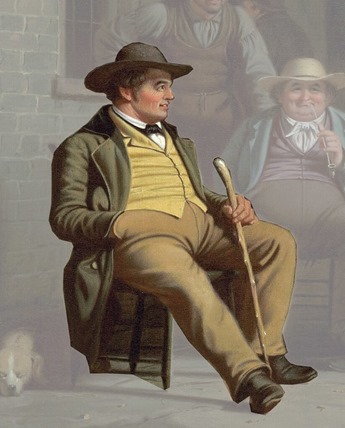 George Caleb Bingham – Canvassing for a Vote
George Caleb Bingham – Canvassing for a Vote
“George Caleb Bingham1 was active in Missouri politics for most of his adult life. Canvassing for a Vote reflects his full faith in the democratic system, even as he recognized its shortcomings. Set in the artist’s hometown of Arrow Rock, Missouri, the composition shows a politician and trio of potential voters in a solid pyramid at the center of the painting, representing the campaign process at work. Bingham also suggests some of the problems of 1850s American politics. A sleeping dog and a man whose back is turned to the solicitation may imply political disenfranchisement and disinterested citizens. Bingham may also be commenting on the dubious character of certain politicians by placing the horse’s rump in line with the canvasser’s head.”

John Beauchamp Jones in George Caleb Bingham’s “Canvassing for a Vote”
In Arrow Rock, Bingham became friends with John Beauchamp Jones, a business owner who would later become a newspaper publisher, novelist, and the author of A Rebel War Clerk’s Diary at the Confederate States Capital2. Bingham is featured in Jones’s novel, The Life and Adventures of a Country Merchant (1854). Bingham may have reciprocated. According to Robin Grey3, in Bingham’s famous election “genre” studies, Jones is the seated figure on the left in the painting Canvassing for a Vote (1851—52:
“Bingham, in fact, is featured as an artist and political stump
speaker in (John Beauchamp) Jones’s novel The Life and Adventures of a Country Merchant (1854). Reciprocally, Bingham painted scenes from their lives in Missouri in his famous studies called the Election Series; Stump Speaking (1850 – 51); Canvassing for a Vote (1851 – 52), in which Jones is depicted (the seated figure on the left in the painting accompanying this essay…”
“This is my own attribution based on photographs of J. B. Jones from various archives. Although other figures in the painting have been identified, this figure has not. It is noted, moreover, in Paul C. Nagel’s George Caleb Bingham that Jones’s autobiographical character Nap Wax (in Life and Adventures of a Country Merchant) was told that every citizen in the town was likely to be in the picture or in the Election Series: ‘Me, too, with my pot-belly. I’ve seen the first sketch of it, and it ’ll be a famous picture . . . better than an advertisement.'”
- From Canvassing for a Vote – 1852. (Google Art Project)
- John Beauchamp Jones, author profile on this site.
- Edgar Allan Poe, John Beauchamp Jones, and George Caleb Bingham: Southern Patronage and the Road Not Taken by Robin Grey.